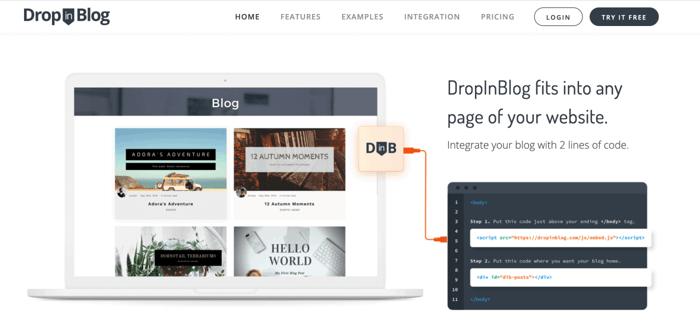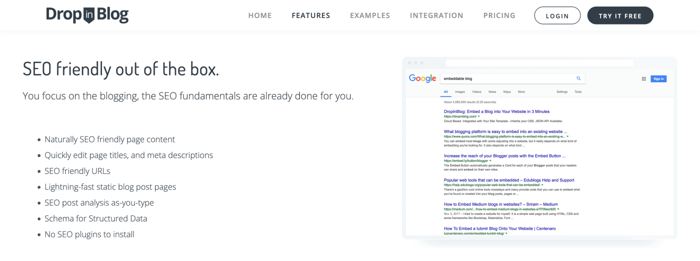As a blogger, you’re surely aware of the benefits of SEO, but if not, we’ve got all the details you need to know. We will elaborate on what SEO is, why it is important – especially for bloggers – and how to optimize your blog and blog posts for SEO. So, SEO for bloggers – let’s get down to it!
Table of Contents
What Is SEO?
Search engine optimization, SEO for short, is the process of fine-tuning a website structure and the content within it. This process enables search engines to easily crawl and index a site and in turn, SEO boosts site traffic. SEO has evolved over time, but it helps search engines process and sort websites so that they can accurately display the best possible search results. These days, with so much competition online, SEO is essential to getting your blog found.
Why Is SEO Important for Bloggers?
Organic traffic from search engines is often the most valuable, directing new visitors to your site so that you can begin to engage with them. Email marketing is great for maintaining a connection with existing readers, but SEO can help you reach new eyes and ears unlike anything else.
A blog that ranks well in search engine results pages (SERPs) also gains authority and presents itself as a credible source. SEO isn’t a science, and there are no hard and fast rules that guarantee success, but there are some basics to follow that will help. Essentially, SEO for bloggers should be a priority.
Using DropInBlog for SEO
Bloggers today have a bountiful range of choices when it comes to blogging platforms to use. One such platform that’s perfect for the job is DropInBlog. DropInBlog is platform-agnostic and works by integrating with whichever platform you host your website on.
Develop and manage all your blog posts from the DropInBlog dashboard, and when you publish, they’ll instantly go live on your website.

DropInBlog is optimized for SEO success right out of the box. Schema markup is automatically applied to your posts, and because of how it’s designed, it’s lightweight and won’t negatively affect page loading speeds. You can edit your URLs and meta title, as well as write your own meta description. It’s even possible to add social sharing buttons to help your blog posts reach a wider audience.

Best of all, DropInBlog includes a built-in SEO Analyzer, which assesses your content as you type. It then provides you with suggestions so you can optimize your content perfectly. By using this tool, you can test your content before you publish it and be sure it’s going to make the grade.

How to Optimize Your Blog Posts for SEO
Optimizing your blog for search engines requires making the structure easily readable, the site fast-loading, and ensuring your blog contains unique information that is helpful to the reader. You need to consider both on-page SEO and technical SEO.
That said, first things first – take a look at what your competition is doing.
Keep an Eye on the Competition
When you’re developing ideas for new blog posts, look at what your competition is blogging about and research what topics are of interest to your readers. All of this can be compiled into a collection of blog post ideas so you can continue to blog on relevant topics even when you’ve run out of fresh inspiration.
Evergreen content is always a good idea because it doesn’t require updating and can be reposted and reused. It saves you a lot of time, and, generally, it has a high search volume and will keep consistent traffic coming to your site.
Remember, write great content – quality is far better than quantity. Your blog posts need to always provide something of value to the reader, whether that’s helpful information or entertainment.
Keywords Are Key
Keywords are the specific words or phrases used to match a user's search intent, and they’re an essential element of blog SEO. We recommend you carefully research the keywords to use in your blog posts, and there are a number of free and paid tools you can use to do this.
Some of the best keyword research tools include Semrush, Ahrefs, and Moz. These tools will conduct a deep analysis of your keywords to establish not only search volume and competition but cost per click or localized data as well. However, for the full range of features, these tools aren’t free. In fact, most of the free tools will have limitations, but you can still complete a pretty decent keyword analysis with only the free tools.
Ideally, you want keywords with a fairly high search volume but low competition. Of course, that isn’t always possible, so it’s about finding the right combination. Using long-tail keywords – phrases of 3-5 words – is also far more effective at matching search intent and driving high-quality traffic to your blog.
Optimize the Content
Optimizing your content requires several fairly simple steps. Little details like adding a meta title and meta description, optimizing the URLs, and using heading tags make all the difference.
Wow with the Title
Creating a really captivating title is a good starting point. The title is the first thing a reader sees and will inform them about the article and grab their attention. Your title must include your keyword, and the trick to making it really grab attention is the type of language used. Using power words, which are words that evoke emotion or action, is proven to be effective in titles.
Include Heading Tags
Adding subheadings throughout your text will help to make your content scannable and generally improve readability. The heading tags are read by search engines and make it easier for them to understand your content.
Write Your Own Meta Title and Meta Description
Search engines like Google will automatically give your content a meta title and description. However, these auto-generated meta descriptions will just be the first couple of sentences and may not accurately summarize what’s in your post.
If you develop your own meta description, you have full control of what’s seen on SERPs. It will also give your content an added “SEO boost” if you can insert your keywords into your headings, meta title, and meta description.
Optimize Your URLs
Most website builders will generate a URL for a new blog post automatically, but they’re not always great. The best URLs are logical and don’t include numbers or symbols. Often, they will give some understanding about the topic of the blog or information on that page. However, not all website builders give you the ability to edit your URLs.
Luckily, DropInBlog does, and you can see some of the many fields you can edit in the image below.

This also comes back to your site structure. A site structure that is logical and easy to navigate is going to get bonus points from a search engine. Make sure your site structure has a logical tree-like structure, for example, myblog.com/blog/how-to-make-more-money/.
Build Internal and External Links
Another easy step in the SEO journey is to incorporate plenty of internal links into your content. Having a network of links running back and forth from relevant or similar articles not only encourages readers to stay on your site longer but also helps search engines understand your content.
But don’t neglect external links, either. Bloggers are often hesitant to direct a reader away from their page with external links. However, as long as you’re including external links to reputable sources and in places where it makes sense, this will add value to the reader and, in turn, benefit the credibility of your site.
Include a Variety of Media
Images and other content like videos are really nice additions to a blog post. However, this content tends to be very large and may slow the loading speed of your pages, which is terrible for SEO.
Make sure images are compressed and always include alt text. Image alt text explains what’s in the image and helps search engines link the images in your blog to search queries.
Mobile-Friendly Pages
Nearly 55% of internet users today browse the web from their phones. Making sure your site is responsive and mobile-friendly gives you many benefits. Readers of your blog will be quickly turned off if they have difficulty reading the text because the formatting doesn’t resize correctly or the layout doesn’t fit the screen.
When a site visitor clicks off the page quickly, this bounce rate has a negative impact on SEO. Search engines favor sites that can hold a reader on the page longer because this indicates a good user experience.
Implement Schema Markup
Schema markup is a simplified code that is easy for search engines to read. It helps search engines characterize different types of content on the page. This is yet another example of making your content easy to crawl and understand, but a very useful one. With schema markup, search engines will also display your data in rich snippets.
Data like ratings, reviews, images, and prices will be displayed on SERPs. It’s also more likely that your content will appear in the frequently asked questions accordion, which is yet another way for your blog to be found online.
Common Mistakes Bloggers Make
Keyword stuffing is a big one, and it’s exactly what you think it is. The intentional overuse of a keyword in order to manipulate the search engine ranking is confirmed to negatively affect a website. So, definitely avoid the temptation to do this and keep the use of keywords natural.
Many bloggers simply forget to optimize for mobile devices. Some platforms or templates are automatically mobile-optimized, but not all. That means you have to make a conscious effort to adjust your pages for mobile devices.
Neglecting monitoring and evaluation is the final major pitfall bloggers make in the SEO optimization process. Because SEO takes time, you have to let it work its magic – but also reassess at various intervals to understand whether the changes are having the desired effect. If they don’t have an impact, then you can make adjustments. Iteration and vigilance are crucial if you’re to have any success with SEO as a blogger.
FAQs
Why are blogs good for SEO?
Blogs help search engines find your site in relation to search queries, which means you can sell more products or simply get more traffic and more readers. SEO for bloggers is an essential tool in the toolbox.
How can I make my blog SEO-optimized?
There are a number of steps to take to optimize your blog. You will need to consider both on-page SEO and technical SEO. On-page SEO includes little details like using heading tags, including a meta description, and adding image alt text.
Technical SEO relates more to site structure and page loading speeds. Always compress images and remove any unnecessary extensions or code that is bloating your site and slowing it down. Following some simple guidelines will help you optimize your blog and get noticed. But, remember, SEO for blogs is a process, and there’s no shortcut to success.
What is a blog SEO strategy?
Developing a blog SEO strategy will help you optimize your blog with a methodical approach. This way, you can monitor the impact of your changes in the most efficient way possible. Blog SEO takes time to show results, and it’s best to set out a six-month strategy. If you’re not getting the desired results – namely, an increase in organic traffic – you can make changes to your SEO strategy.
Final Thoughts
We’ve established that SEO for blogs is essential for blog success. It’s also more of an ongoing process that requires time and patience to see results.
Good SEO for bloggers begins with a logical site structure and URLs. It’s then followed by carefully selected keywords and quality content. Your blog should definitely be mobile-friendly, and consider implementing schema markup to increase your chances of a high ranking on SERPs.
If the platform you blog from doesn’t allow you to make all these tweaks, then you can’t fully optimize your blog. In this case, you might consider migrating to DropInBlog. If you have any questions about how DropInBlog can help your blog succeed, feel free to reach out to the team.





